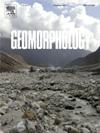A generalized framework for inferring river bathymetry from image-derived velocity fields
IF 3.1
2区 地球科学
Q2 GEOGRAPHY, PHYSICAL
引用次数: 0
Abstract
Although established techniques for remote sensing of river bathymetry perform poorly in turbid water, image velocimetry can be effective under these conditions. This study describes a framework for mapping both of these attributes: Depths Inferred from Velocities Estimated by Remote Sensing, or DIVERS. The workflow involves linking image-derived velocities to depth via a flow resistance equation and invoking an optimization algorithm. We generalized an earlier formulation of DIVERS by: (1) using moving aircraft river velocimetry (MARV) to obtain a continuous, spatially extensive velocity field; (2) working within a channel-centered coordinate system; (3) allowing for local optimization of multiple parameters on a per-cross section basis; and (4) introducing a second objective function that can be used when discharge is not known. We also quantified the sensitivity of depth estimates to each parameter and input variable. MARV-based velocity estimates agreed closely with field measurements () and the use of DIVERS led to cross-sectional mean depths that were correlated with in situ observations (). Errors in the input velocity field had the greatest impact on depth estimates, but the algorithm was not highly sensitive to initial parameter estimates when a known discharge was available to constrain the optimization. The DIVERS framework is predicated upon a number of simplifying assumptions — steady, uniform, one-dimensional flow and a strict, purely local proportionality between depth and velocity — that impose important limitations, but our results suggest that the approach can provide plausible, first-order estimates of river depths.

求助全文
约1分钟内获得全文
求助全文
来源期刊

Geomorphology
地学-地球科学综合
CiteScore
8.00
自引率
10.30%
发文量
309
审稿时长
3.4 months
期刊介绍:
Our journal''s scope includes geomorphic themes of: tectonics and regional structure; glacial processes and landforms; fluvial sequences, Quaternary environmental change and dating; fluvial processes and landforms; mass movement, slopes and periglacial processes; hillslopes and soil erosion; weathering, karst and soils; aeolian processes and landforms, coastal dunes and arid environments; coastal and marine processes, estuaries and lakes; modelling, theoretical and quantitative geomorphology; DEM, GIS and remote sensing methods and applications; hazards, applied and planetary geomorphology; and volcanics.
 求助内容:
求助内容: 应助结果提醒方式:
应助结果提醒方式:


